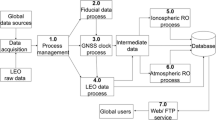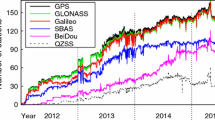Abstract
As seen from comparisons of recent multi-GNSS experiment and pilot project (MGEX) clock solutions of November 23, 2018, and February 15, 2019, most Galileo satellite passive hydrogen maser (PHM) clocks, once corrected for daily drifts, can already show the small error of the conventional relativity correction (i.e., − 2 r.v/c2—negative twice the dot product of the satellite position and velocity vectors, divided by the light velocity squared). The Galileo satellite clock solutions, generated by the GRG and COD MGEX Analysis Centers, in most cases agree well with the simple analytical error approximation, based only on the most significant J2 term of the earth’s gravitational potential expansion. The analytical error approximation is periodical with half an orbit period, and for the Galileo satellites it has an amplitude of 0.064 ns. It is subjected to residual periodical errors with amplitudes of up to 0.025 ns, which also have about half an orbital period. The residual periodical errors are likely caused by orbit perturbations, mostly due to the lunar attraction, which were neglected in the development of the analytical error approximation. Nevertheless, the application of the analytical error approximation to Galileo satellite clocks, corrected for daily drift, resulted in a significant reduction in clock RMS, from the average of 0.095–0.083 ns for GRG MGEX clock solutions on November 23, 2018, and from 0.084 to 0.075 ns on February 15, 2019, for COD MGEX clock solutions. The analytical relativity error approximation improves the linearity of Galileo PHM clocks, which, when accounted for, can result in significant improvements in clock solution precision, clock distributions and predictions. Furthermore, unlike for GPS and GLONASS, Galileo satellite clocks with samplings of 5 or 15 min can be safely interpolated, as demonstrated by Galileo-only kinematic PPP solutions with the MGEX tracking data of Feb. 15, 2019, at the station BRUX. When using the interpolated COD and GRG MGEX SP3 satellite clocks, rather than the 30-s clocks included in the respective clock files, the North/East/Up repeatability sigma’s of 10/8/16 mm increased by less than 10% for COD 5-min SP3 clock sampling. In the case of GRG’s 15-min sampling, the repeatability sigma’s of 8/8/14 mm increased by less than 20%.











Similar content being viewed by others
References
Beutler G (2004) Method of celestial mechanics—theory and applications. Physics monograph. Springer, Berlin, p 783
ICD-GPS-200c (1993) Interface control document. NAVSTAR GPS Space Segment, Navigation user interface, Oct. 10, Revision C, AIR Inc Research Corporation
IERS (2010) IERS conventions (2010), IERS Technical Note 36, (ed. G. Petit and B. Luzum)
Johnston G, Riddell A, Hausler G (2017) The international GNSS service. In: Teunissen PJG, Montenbruck O (eds) Springer handbook of global navigation satellite systems, 1st edn. Springer, Cham, pp 967–982. https://doi.org/10.1007/978-3-319-42928-1
Katsigianni G, Loyer S, Perosanz F, Mercier F, Zajdel R, Sosnica K (2018) Improving Galileo orbit determination using zero-difference ambiguity fixing in a multi-GNSS processing. Adv Space Res. https://doi.org/10.1016/j.asr.2018.08.035
Katsigianni G, Perosanz F, Loyer S, Gupta M (2019) Galileo millimeter-level kinematic precise point positioning with ambiguity resolution. Earth Planets Sp 71:76
Kaula WM (1966) Theory of satellite geodesy. Blaidsdell Pub. Co, Waltham, p 120
Kouba J (2002) Relativistic time transformations in GPS. GPS Solut 5(4):1–9
Kouba J (2004) Improved relativistic transformations in GPS. GPS Solut 8(3):170–180. https://doi.org/10.1007/s10291-004-102-x
Montenbruck O, Steigenberger P, Khachikyan R, Weber G, Langley RB, Mervart L, Hugentobler U (2014) IGS-MGEX: preparing the ground for multi-constellation GNSS science. Inside GNSS 9(1):42–49
Montenbruck O et al (2017) The multi-GNSS experiment (MGEX) of the international GNSS service (IGS)—achievements, prospects and challenges. Adv Space Res 59(7):1671–1697. https://doi.org/10.1016/j.asr.2017.01.011
Acknowledgements
International GNSS Service (IGS) MGEX data and solution products have been used and are gratefully acknowledged here. François Lahaye of the Canadian Geodetic Survey, NRCan, has kindly agreed to read this contribution and provided the author with valuable suggestions and comments.
Author information
Authors and Affiliations
Corresponding author
Additional information
Publisher's Note
Springer Nature remains neutral with regard to jurisdictional claims in published maps and institutional affiliations.
Rights and permissions
About this article
Cite this article
Kouba, J. Relativity effects of Galileo passive hydrogen maser satellite clocks. GPS Solut 23, 117 (2019). https://doi.org/10.1007/s10291-019-0910-7
Received:
Accepted:
Published:
DOI: https://doi.org/10.1007/s10291-019-0910-7




